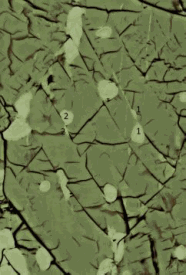More than 20 years ago, geologist Harry Green, now a distinguished professor of the graduate division at the University of California (UC), Riverside, and colleagues discovered a high-pressure failure mechanism that they proposed was the long-sought cause of very deep earthquakes occurring at a depth of more than 400 km (or 248 miles).
The result was controversial because seismologists could not find a seismic signal in the Earth that could confirm the results.
Seismologists have now found the critical evidence. Indeed, beneath Japan, they have even imaged the tell-tale evidence and showed that it coincides with the locations of very deep earthquakes.
In the September 20 issue of the journal Science, Green and colleagues show just how such deep earthquakes can be simulated in the laboratory.
“We confirmed essentially all aspects of our earlier experimental work and extended the conditions to significantly higher pressure,” Green said. “What is crucial is that these experiments are accomplished in a new type of apparatus that allows us to view and analyze specimens using synchrotron x-rays in the premier laboratory in the world for this kind of experiments — the [U.S. Department of Energy Office of Science’s] Advanced Photon Source at Argonne National Laboratory.”
The ability to do such experiments has now allowed scientists like Green to simulate the appropriate conditions within the Earth, and record and analyze the “earthquakes” in their small samples in real time, thus providing the strongest evidence yet that this is the mechanism by which earthquakes happen at hundreds of kilometers depth.
The origin of deep earthquakes fundamentally differs from that of shallow earthquakes (earthquakes occurring at less than 50 km depth). In the case of shallow earthquakes, theories of rock fracture rely on the properties of coalescing cracks and friction.
“But as pressure and temperature increase with depth, intracrystalline plasticity dominates the deformation regime so that rocks yield by creep or flow rather than by the kind of brittle fracturing we see at smaller depths,” Green explained. “Moreover, at depths of more than 400 kilometers, the mineral olivine is no longer stable and undergoes a transformation resulting in spinel, a mineral of higher density”
The research team focused on the role that phase transformations of olivine, a magnesium iron silicate, might play in triggering deep earthquakes. They performed laboratory deformation experiments on olivine at high pressure and high temperature utilizing high-brightness x-ray beams at the GeoSoilEnviroCARS facility at the Advanced Photon Source. They found the “earthquakes” only within a narrow temperature range that simulates conditions where the real earthquakes occur in Earth.
“Using synchrotron x-rays to aid our observations, we found that fractures nucleate at the onset of the olivine to spinel transition,” Green said. “Further, these fractures propagate dynamically so that intense acoustic emissions are generated. These phase transitions in olivine, we argue in our research paper, provide an attractive mechanism for how very deep earthquakes take place.”
Green was joined in the study by Alexandre Schubnel at the CNRS 5Centre National de la Recherche Scientifique (France); Fabrice Brunet at the CNRS 5Centre National de la Recherche Scientifique (France); Nadège Hilairet at the Université de Lille and the CNRS 5Centre National de la Recherche Scientifique (France); and Julian Gasc and Yanbin Wang at The University of Chicago.
The University of California, Riverside, press release by Iqbal Pittalwala can be found here.
See: Alexandre Schubnel1* Fabrice Brunet1, Nadège Hilairet1,2, Julien Gasc3, Yanbin Wang3, and Harry W. Green II4, “Deep-Focus Earthquake Analogs Recorded at High Pressure and Temperature in the Laboratory,” Science 341, 1377 (20 September 2013). DOI:10.1126/science.1240206
Author affiliations: 1CNRS 5Centre National de la Recherche Scientifique, 2Université de Lille, 3University of Chicago, 4University of California, Riverside
*Correspondence: aschubnel@geologie.ens.fr
This work was funded through Institut National des Sciences de l’Univers (project “Deep Quakes”) and L’Agence Nationale de la Recherche (project “DELF”). GeoSoilEnviroCARS is supported by the National Science Foundation–Earth Sciences (EAR-1128799) and U.S. Department of Energy–Geosciences (DE-FG02-94ER14466). Use of the Advanced Photon Source at Argonne National Laboratory was supported by the U.S. Department of Energy Office of Science under contract DE-AC02-06CH11357.
The Advanced Photon Source at Argonne National Laboratory is one of five national synchrotron radiation light sources supported by the U.S. Department of Energy’s Office of Science to carry out applied and basic research to understand, predict, and ultimately control matter and energy at the electronic, atomic, and molecular levels, provide the foundations for new energy technologies, and support DOE missions in energy, environment, and national security. To learn more about the Office of Science x-ray user facilities, visit http://science.energy.gov/user-facilities/basic-energy-sciences/.
Argonne National Laboratory seeks solutions to pressing national problems in science and technology. The nation's first national laboratory, Argonne conducts leading-edge basic and applied scientific research in virtually every scientific discipline. Argonne researchers work closely with researchers from hundreds of companies, universities, and federal, state and municipal agencies to help them solve their specific problems, advance America's scientific leadership and prepare the nation for a better future. With employees from more than 60 nations, Argonne is managed by UChicago Argonne, LLC for the U.S. Department of Energy's Office of Science.

